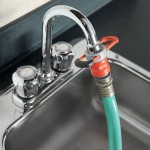How To Install New Faucet In Bathroom Sink
Installing a new faucet in your bathroom sink is a relatively simple plumbing project that can be completed in a few hours. By following these step-by-step instructions, you can save yourself the cost of hiring a plumber and have a new faucet installed in no time.
Step 1: Gather your tools and materials.
You will need the following tools and materials to install a new faucet in your bathroom sink:
- New faucet
- Wrench
- Adjustable wrench
- Plumber's putty
- Teflon tape
- Basin wrench
- Bucket
- Towels
Step 2: Turn off the water supply.
Before you begin working on the faucet, you need to turn off the water supply to the sink. This is typically done by turning off the angle stop valves located under the sink. If you do not have angle stop valves, you will need to turn off the main water supply to your home.
Step 3: Remove the old faucet.
Once the water supply is turned off, you can begin removing the old faucet. Use a wrench to loosen the nuts that hold the faucet in place. Once the nuts are loose, you can pull the faucet out of the sink.
Step 4: Clean the sink surface.
Before you install the new faucet, it is important to clean the surface of the sink. This will help to ensure that the new faucet will create a watertight seal. Use a damp cloth to wipe away any dirt or debris from the sink surface.
Step 5: Apply plumber's putty.
Once the sink surface is clean, you can apply a bead of plumber's putty around the base of the new faucet. Plumber's putty is a type of sealant that will help to create a watertight seal between the faucet and the sink. Use your finger to smooth out the plumber's putty and create a uniform seal.
Step 6: Install the new faucet.
Now you can install the new faucet. Place the faucet on the sink surface and align the holes in the faucet with the holes in the sink. Carefully lower the faucet into place and tighten the nuts that hold it in place. Use a wrench to tighten the nuts until they are snug. Do not overtighten the nuts, as this could damage the faucet or the sink.
Step 7: Connect the water supply lines.
Once the faucet is installed, you can connect the water supply lines. Use an adjustable wrench to tighten the nuts that hold the water supply lines to the faucet. Tighten the nuts until they are snug. Do not overtighten the nuts, as this could damage the water supply lines or the faucet.
Step 8: Test the faucet.
Once the water supply lines are connected, you can test the faucet. Turn on the water supply and check for any leaks. If there are any leaks, tighten the nuts that hold the faucet in place or the nuts that hold the water supply lines to the faucet. Once you have tightened the nuts, test the faucet again. Repeat this process until there are no leaks.
Step 9: Clean up.
Once you have installed the new faucet and tested it for leaks, you can clean up. Use a damp cloth to wipe away any excess plumber's putty or water from the sink surface. You can also use a toothbrush to clean any debris from the aerator.

Diy How To Replace A Bathroom Sink Faucet Remove Install Youtube

How To Replace A Bathroom Faucet Home Repair Tutor

Replacing A Bathroom Faucet Fine Homebuilding

Step By Tutorial How To Install A New Bathroom Sink Faucet Maggie Mcgaugh

How To Remove And Install A Bathroom Faucet

How To Remove And Install A Bathroom Faucet

Bathroom Faucet Replacement For Beginners Making Manzanita

How To Replace A Bathroom Faucet Tinged Blue

Diy How To Replace A Bathroom Sink Faucet Remove Install Youtube

How To Install A Bathroom Sink Step By Guide







